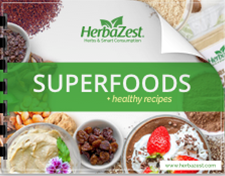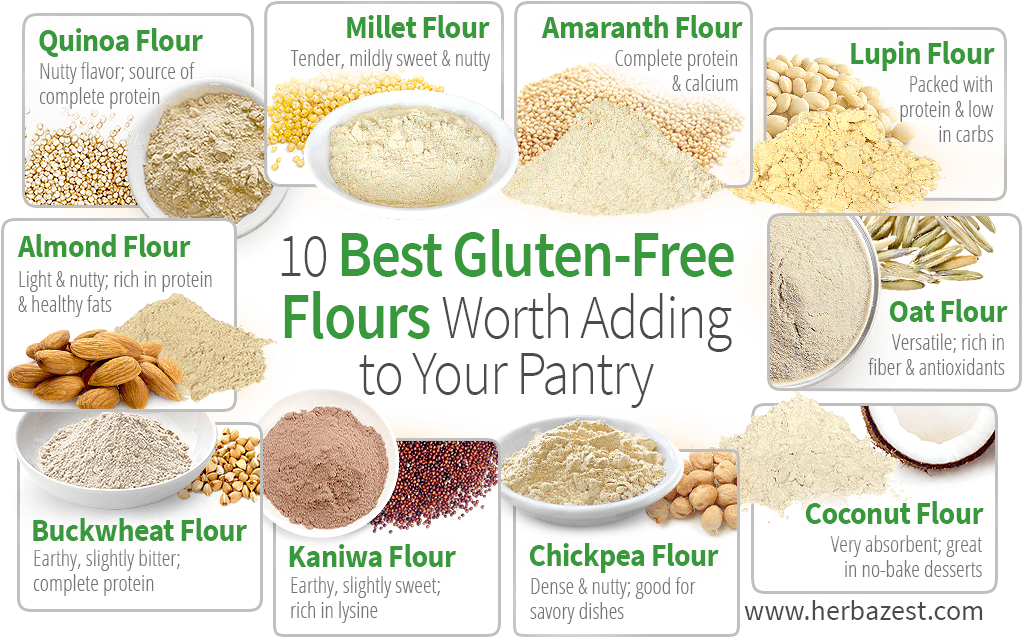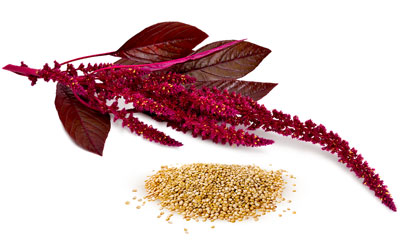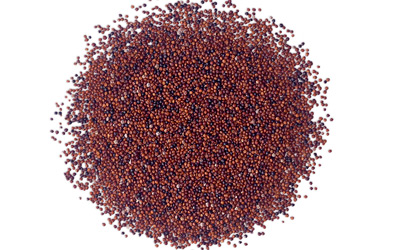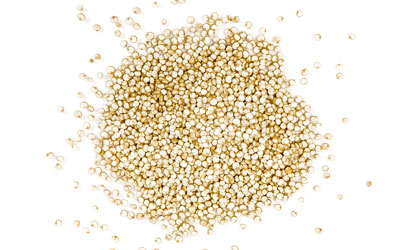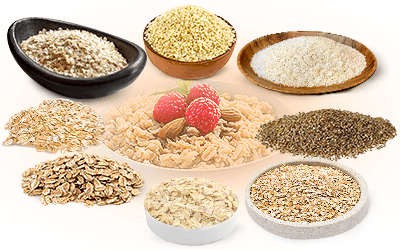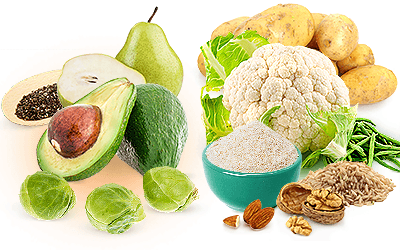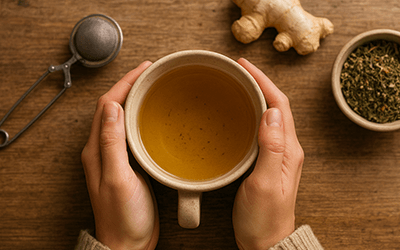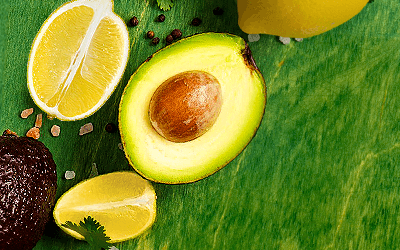Whether you avoid gluten for health reasons, want to add more nutrients to your food, or felt like mixing up your cuisine, there is a wide array of gluten-free flours for you to try.
At first, dealing with gluten-free flours may be intimidating. After all, they do not taste nor behave the same way as wheat flour. But with a dash of patience and a sprinkle of curiosity, you will master the art of cooking without gluten in no time.
Keep on reading to discover 10 best gluten-free flours worth adding to your pantry.
1. Almond Flour
Almond flour is arguably the most popularly used gluten-free flour. Known for its lovely nutty flavor and light texture, it can be easily made at home by simply blanching and then grinding almonds.
Since almonds are packed with healthy fats and quality protein, adding this flour to baking recipes will naturally enrich them with key nutrients. When substituting almond flour for wheat flour, a 1:1 ratio should fit most recipes.
Give almond flour a try in these vegan orange almond cookies, amaranth almond thumbprint cookies, or espresso cookie cups.
2. Quinoa Flour
Appreciated for its pleasantly nutty flavor and protein content, quinoa flour has secured itself a permanent spot among the best gluten-free flours. It can be enjoyed in a wide selection of savory and sweet recipes.
Quinoa has been around for more than 7,000 years, providing indigenous communities with energy and nutrition.1 This Andean flour can replace up to half of the amount of wheat flour needed or be used alongside other gluten-free flours. (In the latter , you may need to add a thickening agent, such as xanthan gum.)
You will enjoy quinoa flour in these gluten-free red quinoa madeleines, red quinoa flour cupcakes, or quinoa carrot bread (not 100% gluten-free).
3. Oat Flour
Oat flour is one of the most versatile gluten-free flours. Having a neutral flavor, it lends well to all kinds of sweet and savory dishes. It is also easy and cost-effective to make at home!
On top of that, oats are a great source of fiber and antioxidants. Oat flour can replace wheat flour in equal amounts by weight. It can also be used in combination with other non-wheat flours.
Try oat flour in these sacha inchi sweet potato muffins with chocolate chips, vegan fruit tarts with lucuma custard, or maca gluten-free bread.
4. Millet Flour
Millet is one of the oldest cultivated crops. When ground, these small, round grains turn into a tender, mildly sweet and nutty flour that can complement many culinary creations.
Naturally rich in complex carbohydrates, protein, and healthy fats, millet is a valuable addition to a daily diet. The flour can either partially replace wheat flour (up to 80%) or be mixed with other gluten-free flours along with a culinary thickener in order to mimic the effect of gluten.
You will love millet flour's undertones in breakfast pancakes, cookies, pizza dough, and bread.
5. Amaranth Flour
A highly nutritious South American pseudocereal, amaranth can be made into a nutty and earthy-flavored flour. It is great for baking recipes, such as breads and cakes, or for preparing delicate porridges.
Closely related to quinoa, amaranth is a good source of complete protein, fiber, and calcium. A good place to start is mixing amaranth flour with other gluten-free flours or using it to replace 25% of wheat flour.
To put amaranth flour to good use, make these amaranth chocolate truffles, amaranth carrot flatbread, amaranth carrot cake pancakes (not 100% gluten-free), or amaranth chickpea brownie.
6. Lupin Flour
Another winner of the best gluten-free flours contest is lupin flour. Though naturally bitter, lupin goes through a special process that results in a nutty and mildly sweet flour.
Being a legume, lupin is packed with protein and low in carbs, making it a more nutritious substitute for wheat flour. However, it is best enjoyed mixed with other gluten-free flours, like almond flour.
Recipes such as almond lupin pancakes with blueberries or walnut cranberry lupin bread (not 100% gluten-free) will bring out lupin's flavor characteristics.
7. Chickpea Flour
Chickpeas are among the most versatile legumes around the world, and chickpea flour lives up to its reputation. Its pleasantly nutty flavor can fit a number of dishes that call for a dense texture.
Most people recognize chickpea for being protein-rich, not knowing that it also contains other nutrients, like potassium and magnesium. It is best to substitute up to half of the required regular flour with that of chickpea.
Because of it's high binding properties, chickpea flour is perfect for making breads, tortillas, and frittatas.
8. Buckwheat Flour
While its name may be somewhat confusing, buckwheat is naturally gluten-free. The flour obtained from this grain is known for its intense flavor that some describe as nutty and earthy, while others find it a bit bitter.
Nevertheless, buckwheat enriches dishes with fiber and all essential amino acids, making it a good source of complete protein. Depending on the recipe, start by using 25% of buckwheat flour and build up to about 50%.
You may best enjoy this gluten-free flour in homemade buckwheat wraps, morning pancakes, bread, tarts, and pasta.
9. Kaniwa Flour
Still largely unknown to the Western world, kaniwa has been a source of nutrition to Andean people for thousands of years. Dark in color with a nutty, slightly sweet flavor, kaniwa flour is a great gluten-free flour choice.
Kaniwa belongs to the quinoa family, hence its rich nutritional profile. It offers good amounts of protein, especially lysine, and it is abundant in phenolic compounds. For starters, use kaniwa flour to replace 25-50% of wheat flour.
Kaniwa flour works best in recipes such as orange bars with kaniwa flour, nutritious kaniwa flour porridge, or wholesome kaniwa cinnamon rolls (not 100% gluten-free).
10. Coconut Flour
Coconut flour is a delicious product of dried coconut meat. Popularly used in raw desserts and pancakes, it gives recipes a lovely flavor and light texture.
Coconut is packed with fiber, healthy fats, and protein. Adding coconut flour can be tricky at first because of its dense flavor and higher water absorption than other flours. It may be worth adding an extra egg to the recipe to improve final results.
You may enjoy coconut flour in these chocolate coconut flour muffins with cacao nibs and vegan maca crepes.
In addition to learning how to use gluten-free flours, perhaps one of the most crucial skills gluten-free folks must develop is how to read food labels. Even though a product is naturally free of gluten, it may be processed in a facility that handles other gluten-containing foods, which can result in cross contamination. A recognized gluten-free certification seal is something to pay close attention to when food shopping.
Sources
- Better Health Channel, Gluten-free diet
- Beyond Celiac, Intro to Gluten-Free Flours
- Celiac Disease Foundation, Gluten-Free Foods
- Nutrients, Flour for Home Baking: A Cross-Sectional Analysis of Supermarket Products Emphasising the Whole Grain Opportunity, 2020
Footnotes:
- Frontiers in Plant Science. (2016). The Global Expansion of Quinoa: Trends and Limits. Retrieved January 15, 2020 from https://www.ncbi.nlm.nih.gov/pmc/articles/PMC4860459/
